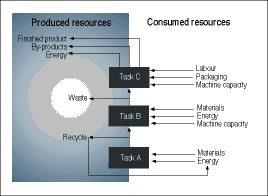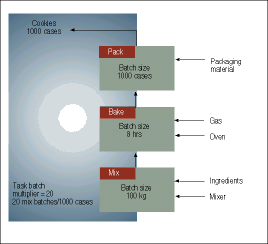
In the complex world of food processing, disassembling chickens need not only be bad news for the chickens
While MRPII systems are the backbone of today's discrete manufacturing industry, the world of food manufacturing and processing has other needs. Its complexity requires solutions that address the everyday issues of multiple outputs, by-products and recycling in a coordinated way that will support business decisions at all levels.
While the traditional bill of material and routing method has proven to be a productive tool for discrete operations, it has historically fallen short in delivering substantial benefits for process companies. This traditional method has been unable to deliver the flexibility and depth of function mandated by the unique business requirements of the process environment. Over the past three decades hundreds of process companies, and companies with process operations, have tried to implement traditional MRP systems, have spent millions of dollars on modifications and have met with little success.
Food processing companies must manage several complicated planning, production, inventory, reporting and costing issues as part of their daily operations. These include:
1. Managing batches of output.
2. Managing multiple outputs.
3. Controlling recycled material.
4. Managing all resources including material, substitutions, labour, equipment and energy.
5. Accommodating multiple formulations and production methods.
"One way of doing this," says Ian Huntly, Business Development Manager at Futuristix-Wonderware, "is to have a production model that can accurately depict (and track) the realities of production in continuous and batch processes. This includes combining formula or recipe requirements with operational realtime information such as available from Wonderware's FactorySuite range of solutions."

Production models contain a complete definition of all resources required for production. A resource is any element required to run the production process, like material, labour, energy and capacity, or produced by the process, like finished goods, by-products, recycles and waste. By managing all resources, production models more easily accommodate unique process requirements including: formulae and routings that may vary slightly based on the process scheduled, yields that fluctuate with technology uses, recycles, energy, waste, labour and equipment planning as well as co-product and by-product production.
Managing batches of output
Food processing companies typically plan production in relation to batch factors, like the mass of produced product, the number of cases needed, or even the amount of time required to produce a final product. Accurately planning batches of product that feed continuous operations requires an additional level of system control unavailable in traditional systems.
Planning is more complicated in this environment because different batches of the same product may be processed on different lines. Planning must also recognise the batch constraints of the different equipment options. In addition, batch size planning may involve scaling some required resource in linear proportion to the produced item while consuming other resources in a fixed amount per batch. Customer orders may be received in one unit of measure but produced in other units of measure. Each of these issues must be planned, reported and costed accurately to add value within the process operation. The following batch example illustrates the point.
Consider a cookie manufacturer who takes orders for a product in cases but schedules production in 100 kg batches of cookie dough (see Figure 2). Batches of dough are fed into continuously-running ovens.

For this manufacturer, an order for 65 cases of cookies might equate to 1,3 batches of dough. Making a third of a batch of dough, however, may be undesirable due to the production constraint of improper mixing action. An effective planning system needs to provide the option of automatically scaling up the production quantity to make a second whole batch, or, if it is feasible to properly mix 1,3 batches may need to mix for as long as two whole batches. At the end of the run, reports need to be produced for kilograms of dough produced during the mix process and for the continuously running ovens that produce cases of finished cookies.
Production models easily accommodate the planning and reporting complexities of batch factors. Each task within the production model can be defined relative to the batch/capacity constraints at that task. Resources consumed at each task can either be consumed in linear proportion to the batch quantity or in a fixed quantity per batch. Requirements in one unit of measure (UOM) automatically translate into the batch unit of measure at the production task level. Production is reported at each task and for the completed production model in the units used by the operations people measuring the production activity at that task. Reporting information, therefore, is more logical to the people interpreting the report.
Managing multiple outputs
"Some processes convert natural resources into multiple outputs including end items, by-products and waste materials," continues Huntly. "Examples of conversion or disassembly operations include meat and poultry processing. Other processes assemble multiple resources to produce multiple outputs including co-products, by-products, waste and graded material. An example of this type of process is a soap manufacturer who produces multiple package sizes of soap on the same production line. The soap manufacturer must also manage crude glycerine and fatty acid outputs that need to be accounted for, disposed of, or recycled. For both types of process companies, managing multiple outputs complicates planning, costing and reporting."
To manage multiple outputs, planners need to schedule co-product production to meet anticipated demand. Planners also need to plan for by-products as well as the disposal of waste and scrap that is placed in inventory. Management needs to be able to proportionally distribute product costs to all types of outputs. In addition, management must be able to easily distribute changes to the cost of input materials to ensure the continued accuracy of product costs. The costing system needs to be able to assign positive or negative costs to by-products and waste. For example, good product outputs need to reflect waste disposal charges. On the other hand, if there is a positive value to the by-product, cost accountants need to be able to credit the production process. Another requirement is for multiple output quantities to be reported against a single production schedule.
Food and beverage companies managing multiple output operations need a straightforward system for master scheduling, planning, costing and reporting. To use traditional systems in this type of an environment mandates workarounds which only serve to multiply planning, scheduling and costing complexities and increase the likelihood that the system will not be used.
"Wonderware's Protean, a component of ProductionSuite, not only has a patented production model as shown above but also caters for inverted bills of materials such as are found in the meat and poultry processing industries," says Huntly. "Understanding the unique requirements of the poultry industry has helped us design manufacturing solutions that model the complex, multistep disassembling operations required for effective process control and management. In addition, our solutions monitor catchweight, by-product and co-product tracking, shelf life and lot/sub-lot control - all of which are of critical importance to the food industry. Wonderware's process industry solutions enable manufacturers to plan and schedule their processes while managing and responding to ever-changing customer demands."
See Part II of III in March issue.
Futuristix
(011) 723 9900

© Technews Publishing (Pty) Ltd | All Rights Reserved